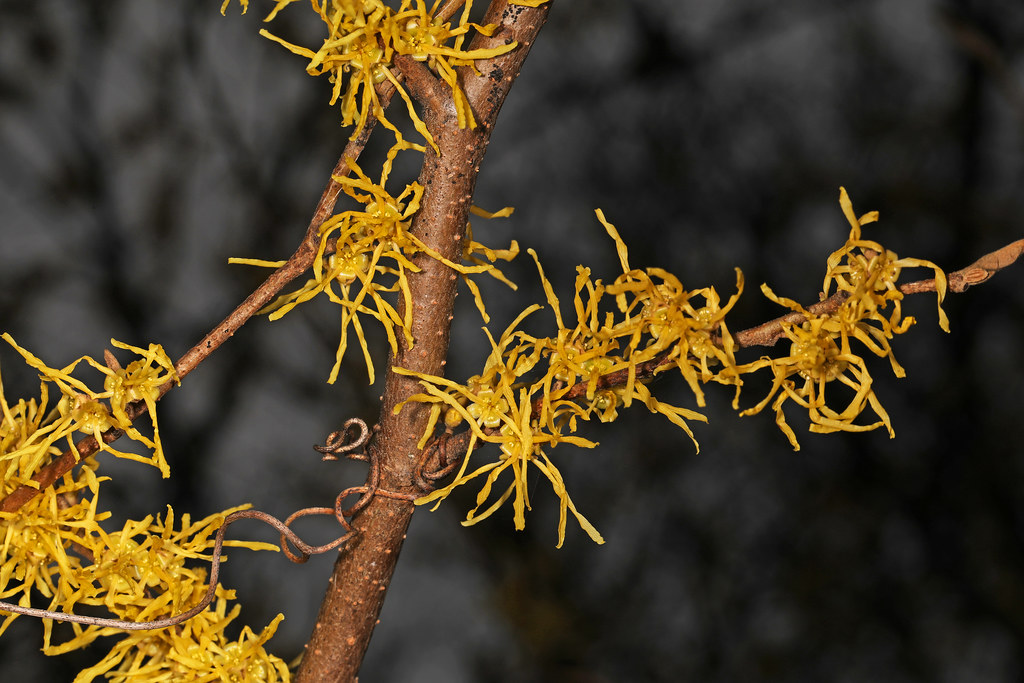Disclaimer: This Materia Medica is provided for informational purposes only and should not replace professional medical advice. Please consult with a qualified healthcare practitioner or herbalist before using any herbal remedies.
Materia Medica: Witch Hazel (Hamamelis virginiana)
Introduction: Witch hazel (Hamamelis virginiana) is a versatile and widely used medicinal plant renowned for its numerous therapeutic properties. As a professional herbalist, I’ll provide an exhaustive materia medica for witch hazel, offering insights into its botanical characteristics, historical uses, preparation methods, and contemporary applications.
Botanical Description:
- Botanical Name: Hamamelis virginiana
- Common Names: Witch hazel, winterbloom
- Family: Hamamelidaceae
- Parts Used: Bark, leaves, and twigs
- Habitat: Native to North America, primarily the eastern United States.
Botanical Characteristics:
- Tree or Shrub: Witch hazel is a deciduous shrub or small tree that can reach heights of 10 to 30 feet.
- Leaves: The leaves are alternate, oval-shaped, and have a wavy margin. They turn vibrant shades of yellow and red in the fall.
- Flowers: Witch hazel blooms in late fall or early winter when most other plants are dormant. Its fragrant, spidery yellow flowers have distinctive ribbon-like petals.
- Fruit: The fruit is a woody capsule that contains seeds. When the seeds mature, the capsules forcefully expel them.
- Bark: The bark is smooth and gray, with astringent properties.
Historical Uses:
- Native American Medicine: Indigenous peoples in North America, such as the Osage and Iroquois, used witch hazel for various medicinal purposes, including wound healing and as a soothing agent.
- Early American Settlers: European settlers adopted Native American remedies, and witch hazel became a common folk remedy in colonial America.
- Topical Applications: Witch hazel was traditionally used topically for skin conditions, bruises, and insect bites.
- Hemorrhoid Treatment: Its astringent and anti-inflammatory properties made it a popular remedy for hemorrhoids.
Constituents: Witch hazel contains several active compounds, including:
- Tannins: Responsible for its astringent properties.
- Flavonoids: Known for their antioxidant effects.
- Gallic Acid: Provides anti-inflammatory benefits.
- Essential Oils: Contribute to its aromatic properties.
Preparation Methods:
- Witch Hazel Extract: The most common preparation involves making an extract from the leaves, bark, or twigs. This extract is often available commercially as witch hazel water.
- Infusions and Decoctions: Infusing or decocting witch hazel leaves can yield teas for internal use, although it’s more frequently used topically.
- Compresses: Soaking a cloth in witch hazel extract and applying it to the affected area can relieve skin irritations and inflammation.
Contemporary Applications:
- Skin Care: Witch hazel is renowned for its skin-soothing properties. It is used as a natural astringent and toner, helping to tighten pores and reduce acne breakouts.
- Hemorrhoid Relief: Witch hazel can alleviate the discomfort associated with hemorrhoids when applied topically.
- Anti-inflammatory: Its anti-inflammatory effects are beneficial for treating minor cuts, burns, and insect bites.
- Eye Irritation: Witch hazel can be used to soothe irritated eyes, although it should be used cautiously and not directly in the eye.
- Anti-aging: Some skincare products incorporate witch hazel for its potential to reduce signs of aging, like wrinkles and fine lines.
Safety and Precautions:
- Witch hazel is generally considered safe when used topically in recommended doses.
- It is crucial to ensure the product is pure and not mixed with alcohol or other additives that may cause skin irritation.
- Internal use should be approached with caution and under the guidance of a healthcare professional.
- Allergic reactions are rare but possible, so perform a patch test before applying it widely on the skin.
Conclusion: Witch hazel’s enduring popularity as a medicinal plant is a testament to its efficacy in various applications, particularly in skincare and minor wound care. As a professional herbalist, it’s essential to understand its botanical characteristics, historical uses, preparation methods, and contemporary applications to provide effective and safe herbal remedies to clients. Always advocate for responsible and informed herbal usage.






